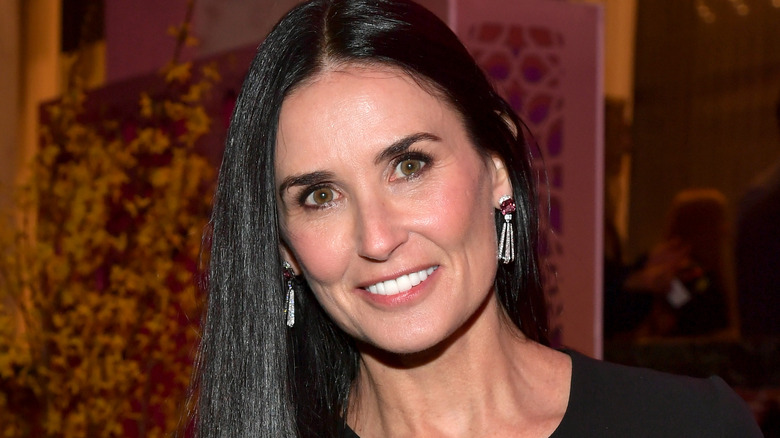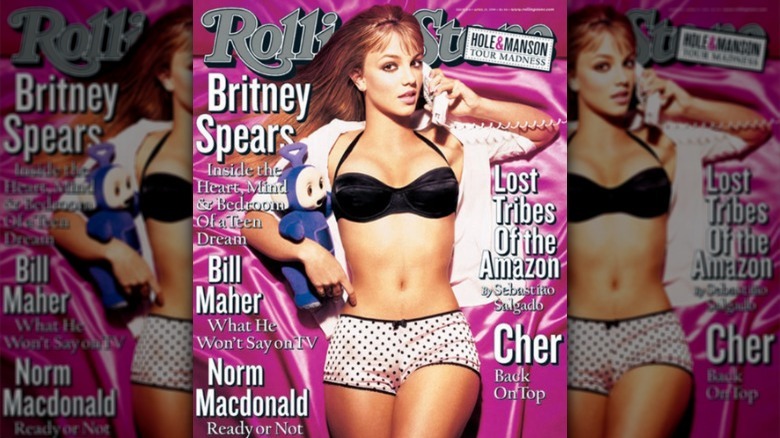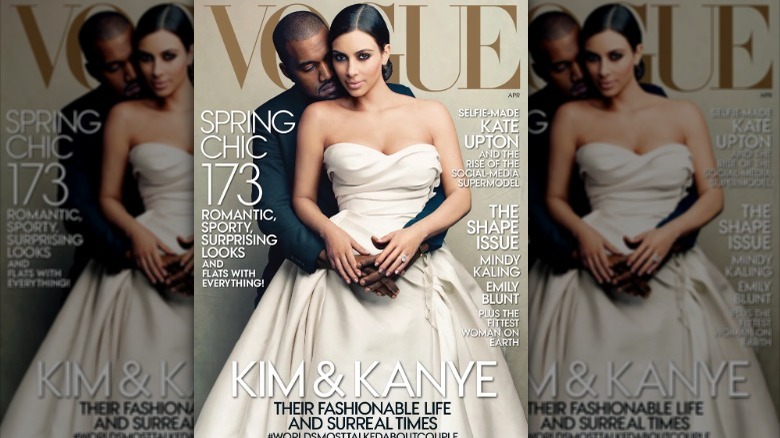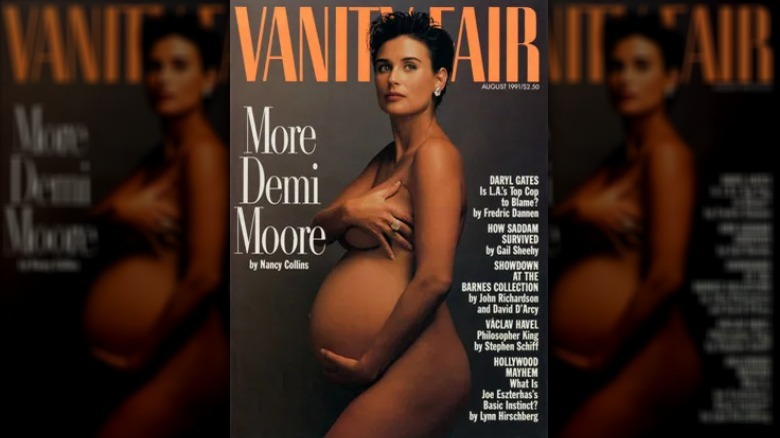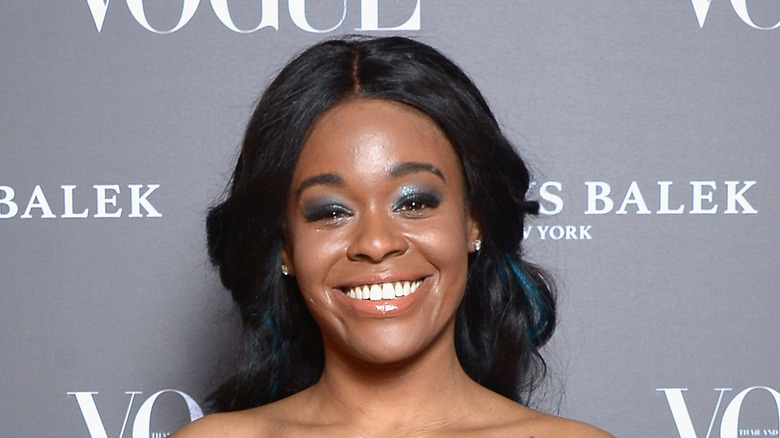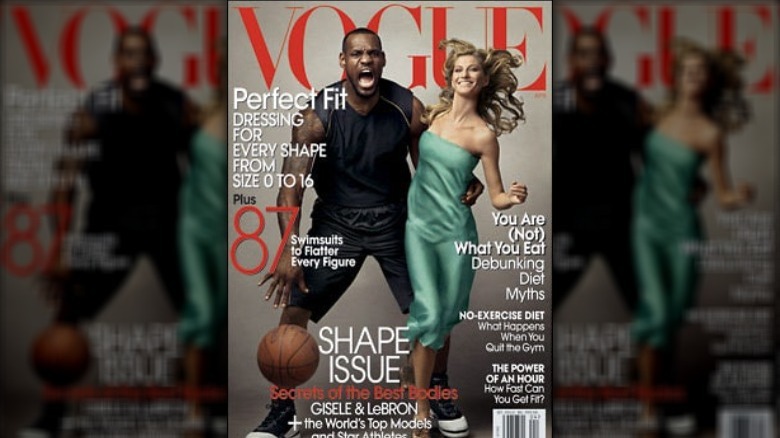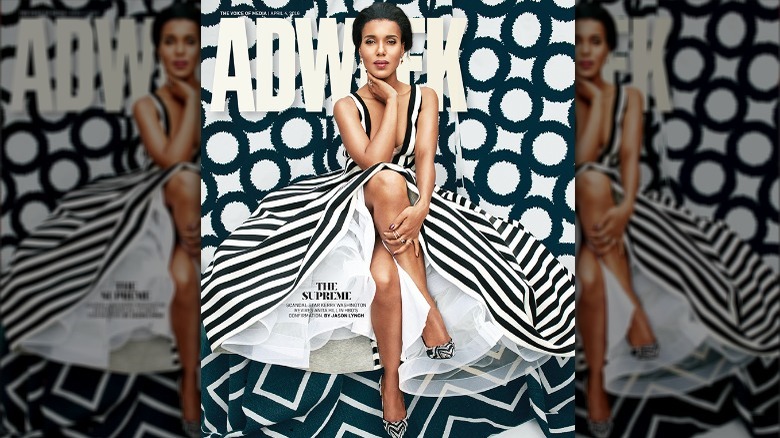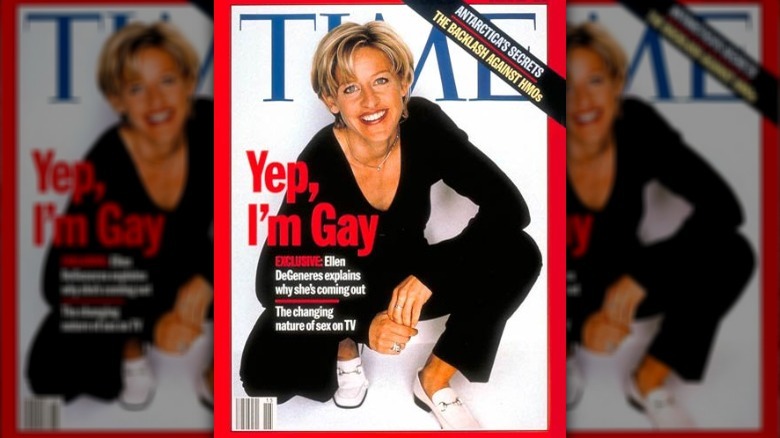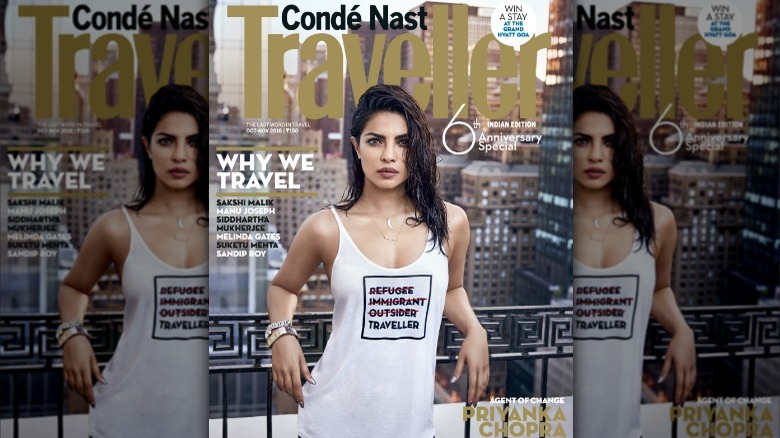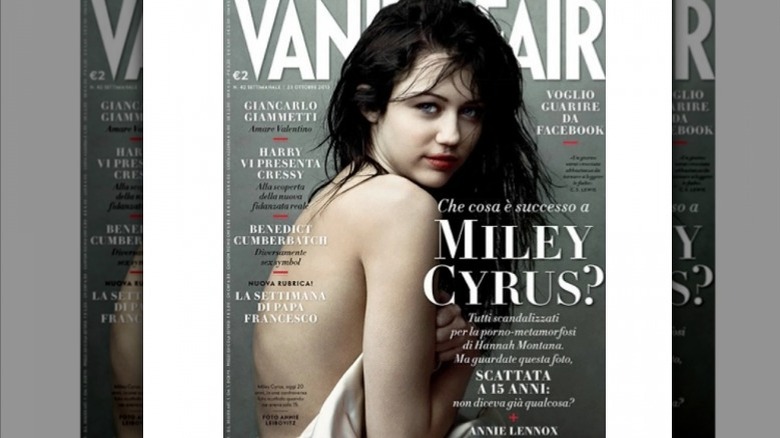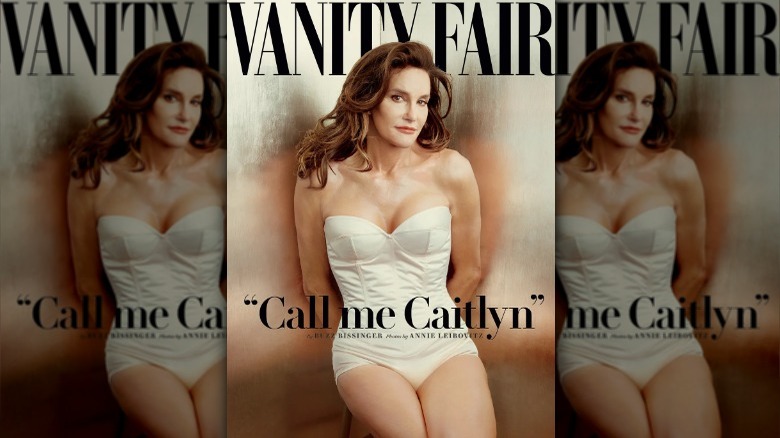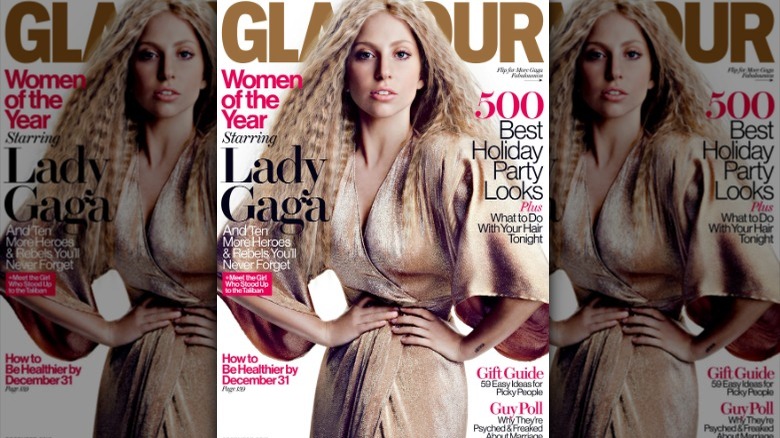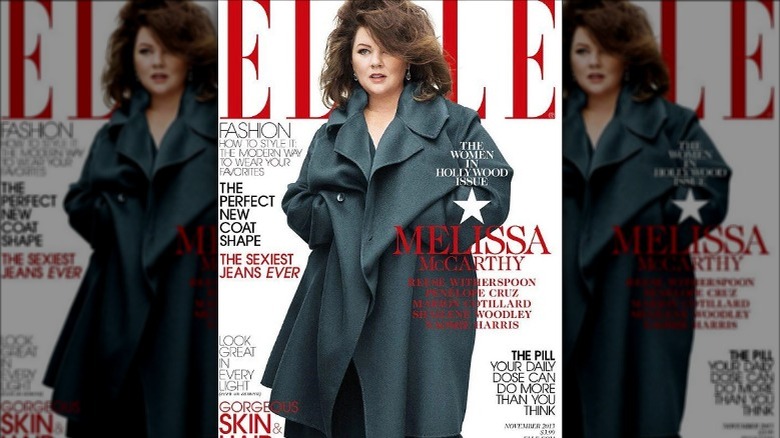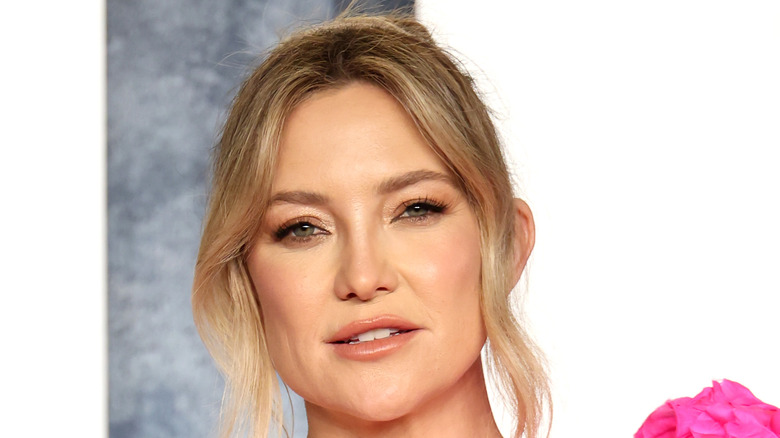Controversial Celebrity Magazine Covers That Caused A Stir
Time and time again, we've seen magazines put someone or something on their covers that strikes a nerve. From featuring a politician in a negative light to making a big statement about a current event, publications know how to drum up reactions from their readers. And a controversial cover featuring an A-list celebrity? That's definitely going to get tongues wagging.
We've seen backlash over too much retouching and editing, making a star pretty much unrecognizable. There's been criticism over nearly nude celebs on the front covers of major publications that some stores refused to sell. And we've seen one particular "fashion bible" face the wrath of angry readers for including a a reality star on its cover who, at the time, had not yet released her very successful shapewear line.
Ready to take a look at some magazine covers that caused quite a stir when they made their way to newsstands? Here's all the drama that's fit to print.
Britney Spears' Rolling Stone cover made parents furious
At 16, Britney Spears became an overnight sensation when she released her debut song "...Baby One More Time" and its accompanying music video. Young girls wanted to be like her and teen boys most definitely owned a copy of her very controversial Rolling Stone magazine cover.
In 1999, Britney not only debuted her first album, "...Baby One More Time," which found its way to the No.1 spot on the Billboard charts, but she also posed rather provocatively on her first cover for Rolling Stone. Photographer David LaChapelle shot the photos in her childhood bedroom in Kentwood, Louisiana. The singer, then 17 years old, posed on her bed while wearing lingerie. It didn't sit right with parents, who found that the magazine sexualized the star and had set a bad example to young girls. Plus, there'd already been a lot of chatter about her debut music video and her now-iconic schoolgirl outfit.
In 2008, Britney's mother, Lynne Spears, spoke with "Today" cohost Meredith Vieira and admitted she had no control over what photos would be published by Rolling Stone. "We didn't really know what we were doing, we were kind of in shock at what was going on, and in awe at the same time," she shared. Decades later, Britney's RS cover is still talked about to this day.
A reality star on the cover of Vogue caught flak
Vogue has been around over 130 years, and it has undoubtedly evolved, especially with regards to who is chosen to grace the fashion bible's cover. In the '80s and '90s, Vogue's covers mostly featured supermodels like Kate Moss, Linda Evangelista, and Cindy Crawford. However, by the early 2000s, it was totally normal for non-supermodels to grace the cover, and celebrities like Rihanna, Selena Gomez, and Michelle Obama landed on the front of the mag.
Even so, when Vogue's editor-in-chief Anna Wintour decided to put Kim Kardashian and then-husband Kanye West on the April 2014 cover, backlash followed. Inspired by their lavish May 2014 wedding in Italy, Kardashian wore a wedding gown while the rapper wrapped his arms around his new bride. However, those in the fashion industry were not happy to see a reality star on the high-end fashion publication, and there were even rumors that West begged Wintour to put his wife on the cover.
Despite the negativity surrounding the issue, Wintour defended her decision. In a trailer for her MasterClass, she shared, "This cover was a deeply controversial cover. But Kim and Kanye were a part of the conversation of the day. And for Vogue not to recognize that would have been a big misstep. You are leading, you are not following – and that's a very important lesson to always keep in your mind."
Demi Moore's Vanity Fair cover became iconic
When it hit shelves in 1991, the issue of Vanity Fair that featured a naked and pregnant Demi Moore on the cover was banned from some stores. Moore was eight months pregnant with her daughter Scout Willis, who she shares with Bruce Willis. The iconic shot was photographed by famed photographer Annie Leibovitz and has since become one of her most famous images.
At its release, AP News reported that several grocery stores across the U.S., including Giant Food Inc., decided it was too inappropriate for their magazine racks — even though Moore's body was covered by the issue's wrapper. Meanwhile, stores selling the magazine saw a record number of sales, including one newsstand that sold 600 copies in six days. A whopping 1.2 million copies of the issue were sold.
Over the years, many other celebrities have recreated Moore's impactful cover including, Cindy Crawford, Jessica Simpson, and Serena Williams. Almost 30 years after its release, Moore spoke about her famous cover with Naomi Campbell during her "No Filter" series on YouTube in 2021. "I understand what impact it had on the world. On women, on our permission to embrace ourselves in a pregnant state. But it was a moment that I was taking to be really in myself and be expressing myself and not trying to be anything other than me," Moore shared.
Azealia Banks' cover was banned in multiple countries
Azealia Banks came on the music scene in 2011 with her debut song "212," but she has since become more known for her Twitter feuds and questionable behavior than her music. No stranger to controversy, she made headlines for her risqué cover of Dazed & Confused magazine's September 2012 issue even before it was released.
Before the magazine revealed her cover, the publication tweeted that seven countries banned the issue from being sold: "Just been told that our upcoming @AZEALIABANKS cover has been banned from 7 countries so far. Thank God for the Internet, huh?" So, what was all the fuss? On the cover, the rapper blows up a pink condom and appears to be holding it like a cigar. The headline: "Azealia Banks Blows Up." However, there was no word about which countries banned the magazine from its stores, and Banks didn't make much fuss about it on Twitter.
Fashion photographer Sharif Hamza captured the photos of Banks for the issue. However, it wasn't his first controversial shoot. In 2011, Hamza's editorial shoot titled "Cadeaux" for Vogue Paris — which featured child models wearing tons of makeup, heels, and loads of jewelry — was highly talked about. The shots were deemed overly sexualized by some.
LeBron James and Gisele Bündchen's Vogue cover drew backlash
Since 2002, Vogue magazine has called its April issue the "Shape Issue," dedicating it to health, fitness, and beauty. However, when the magazine released its April 2008 issue that featured supermodel Gisele Bündchen and NBA star LeBron James on the cover, it didn't sit right with some. Though James made history as he became the first Black man to be featured on the coveted fashion magazine, how he posed next to the model drew criticism.
On the cover, James is dribbling a basketball in one hand while his other hand is holding onto Bündchen. James is in full game mode and appears to be yelling, whereas Bündchen is smiling in her green strapless dress. Readers took issue with the cover's overall direction, and some compared it to the 1933 poster for the classic film "King Kong," which features the giant gorilla holding white actor Fay Wray.
ESPN reporter Jemele Hill called the Vogue cover a "distasteful" depiction of a Black man. "Vogue's quest to highlight the differences between superstar athletes and supermodels only successfully reinforces the animalistic stereotypes frequently associated with black athletes," she wrote. "A black athlete being reduced to a savage is, sadly, nothing new." In a statement to Today, a Vogue spokesperson shared that the magazine "sought to celebrate two superstars at the top of their game."
Kerry Washington didn't recognize herself on Adweek
Magazine covers and Photoshop have gone hand in hand for years. So though a slight touch-up here or there never hurt, actor Kerry Washington was extremely displeased when her April 2016 cover for Adweek magazine was released. The "Scandal" actor believed her cover, in which she wears a stunning black and white striped gown, was overly doctored to the point that she didn't even recognize herself.
Washington took to Instagram to call out the magazine's failed Photoshop job. After addressing her adoration for the publication, she shared, "Look, I'm no stranger to Photoshopping. It happens a lot. In a way, we have become a society of picture adjusters – who doesn't love a filter?!?" She continued, "Yesterday, however, I just felt weary. It felt strange to look at a picture of myself that is so different from what I look like when I look in the mirror. It's an unfortunate feeling."
Washington has fallen victim to major editing fails with magazines. For example, while covering the March 2015 issue of InStyle, fans were upset to see that Washington's skin color appeared to be lightened. Likewise, when Washington posed on Lucky magazine's December 2013 cover, people were baffled at how unrecognizable she looked.
Ellen DeGeneres' big announcement on the cover of Time
Ellen DeGeneres announced that she was gay on the cover of Time magazine's April 1997 issue. The magazine's headline read: "Yep, I'm Gay." Just weeks later, DeGeneres' character, Ellen Morgan, on her hit television show, "Ellen," also came out in a Season 5 episode titled, "The Puppy Episode." Approximately 42 million viewers tuned in to watch the episode.
DeGeneres faced a wide array of criticism after she announced her sexuality. She had to defend her choice to come out during an interview with Oprah Winfrey, which saw audience members expressing their anger at the comedian for doing so. Even queer rights activists like Chaz Bono believed her sitcom was becoming "too gay." As a result, ABC canceled the show after its fifth season, and DeGeneres' career sat in the shadows for quite some time. However, fans of DeGeneres would see her again when she launched "The Ellen DeGeneres Show" in 2003. Running until 2022, it became one of the longest-running talk shows in history.
Despite all the controversy, coming out was a monumental moment for the host and changed American television. Looking back on the episode 25 years later, the comedian shared on her talk show, "When I came out, people warned me that it was going to ruin my career, and they were right for a while. Actually, for exactly three years, I lost my career. But look at me now."
Priyanka Chopra apologized for her Condé Nast Traveller cover
Condé Nast Traveller India's October/November 2016 issue featured the lovely Priyanka Chopra on its cover. However, when the issue was released, several people pointed out that what was on Chopra's shirt was insensitive and even thoughtless. On the cover, the actor wears a white tank top with the words "refugee, immigrant, outsider, and traveller," with the first three words crossed out.
The shirt caused controversy as the global refugee crisis has been a hot topic. The magazine created the shirt for Chopra to wear and issued a statement explaining that it was to fight xenophobia: "At Conde Nast Traveller, we believe that the opening up of borders and the breaking down of walls can help us discover the world, and open up our minds and hearts. So, when we had actress Priyanka Chopra wear a T-shirt we created on the cover of our 6th-anniversary issue, we had a point to make. And it's not about privilege or fashion."
During an interview with an Indian news network, Chopra issued an apology. "I am really, really apologetic about the fact that so many sentiments were hurt ... Of all people, I'm someone who always stands for no labels," the actor said, adding, "The point the magazine wanted to make was actually something good."
The media shamed Miley Cyrus for her Vanity Fair cover
In 2008, 15-year-old Miley Cyrus caused a stir when she posed semi-nude for the cover of Vanity Fair. Shot by famed photographer Annie Leibovitz, the songstress was wrapped in a white sheet with her exposed back to the camera. Still acting on Disney's "Hannah Montana," the image became controversial. The media shamed Cyrus for the photos, and parents believed Cyrus was no longer a good role model by showing too much skin. The New York Post made it their cover story, splashing "Miley's Shame" and "TV's 'Hannah' apologizes for near-nude pic" across the front of the issue. According to The New York Times, Disney blamed the magazine, with a spokesperson stating that "a situation was created to deliberately manipulate a 15-year-old in order to sell magazines."
And, yes, Cyrus did end up apologizing for the pictures, despite stating in her Vanity Fair interview that she found the images artistic. However, 10 years after the cover was released, the "Flowers" singer decided to take back her apology. In a 2018 tweet, Cyrus wrote, "IM NOT SORRY F*** YOU #10yearsago," and included the original New York Post article cover.
During an interview with Jimmy Kimmel, Cyrus defended her Vanity Fair photos and stated that the media turned her photos into something they were not. "It was everyone's poisonous thoughts and minds that ended up turning this into something that wasn't meant to be. So actually, I should not be ashamed, they should be," Cyrus explained, adding that she was forced to apologize.
Caitlyn Jenner sparked mixed reactions over her Vanity Fair shoot
In April 2015, Caitlyn Jenner came out as transgender in an interview with Diane Sawyer for "20/20." Two months later, Jenner posed on the cover of Vanity Fair, shot by Annie Leibovitz, with the story title "Call me Caitlyn."
Jenner received high praise for coming out from celebrity friends like Ellen DeGeneres, Lena Dunham, and her daughter Kendall Jenner. Even President Barack Obama applauded Jenner, tweeting, "It takes courage to share your story." GLAAD President Kate Ellis stated, "By sharing her journey with the world, Caitlyn Jenner is accelerating acceptance of transgender people everywhere." Jenner even broke a record that wasn't an Olympic one this time — becoming the fastest person to reach one million Twitter followers.
However, not everyone was pleased with Jenner's photos. Some members of the transgender community believed Jenner's Vanity Fair spread, featuring the Olympian in designer dresses and her million-dollar home, was something unattainable and even unrelatable to many transgender people. "She doesn't necessarily represent the experiences of the majority of trans people," Laura Erickson-Schroth, of Columbia University LGBT health and public psychiatry told The Wrap, adding, "I think many are middle or lower class; they're people of color; they don't have access to necessarily good mental health care, hormones, surgeries – the kind of things that Caitlyn might have access to, being someone who's wealthy."
Lady Gaga took issue with Glamour's retouching
Lady Gaga was named Women of the Year by Glamour magazine in 2013, and with that came a cover and spread for the December issue of the mag. Lady Gaga is one celebrity that has always stayed true to herself, so it wasn't surprising when she shared in her Glamour interview, "I'm confident in who I am. I've come to a place in my life where I've accepted things that are me, as opposed to feeling pressure to explain myself to people around me. That's just the way I've always tried to be. It didn't change when I became a star."
So, during her acceptance speech for the Glamour Women of the Year award, she criticized the magazine for retouching and editing her images while asking publications for a change. And was it awkward? Probably. But, Gaga made a brilliant point about how her cover and other covers of celebrities who have been altered to look "perfect" can harm young people. "I felt my skin looked too perfect and my hair looked too soft. ... I do not look like this when I wake up in the morning," the songstress said on stage, adding, "It's fair to write about the change in your magazines, but what I want to see is the change on your covers. When the cover changes ... this is when culture will change."
Elle magazine got called out for sizeism
Elle magazine was accused of sizeism after featuring Melissa McCarthy in an oversized coat on the cover of their November 2013 "Women in Hollywood" issue. The other celebrities featured on that month's cover, including actor Shailene Woodley, dawned a bathing suit and sneakers.
Writer June Thomas of Slate magazine was alarmed by how the magazine covered up McCarthy while other celebs who were honored with a cover wore skin-tight ensembles. (Although Penelope Cruz's cover featured a closeup of her face.) "McCarthy's hair covers a quarter of her gorgeous face, and with her hands stuffed deep into her coat pockets, the only visible flesh is a tiny triangle between the coat's lapels and the briefest glimpse of calf. Perhaps photographer Thomas Whiteside only knows how to photograph the usual stick insect models, because he clearly has no clue how to highlight McCarthy's curves," Thomas wrote.
According to Today, after receiving backlash over the cover, Elle issued a statement and insisted that McCarthy was happy with her ensemble. "On all of our shoots, our stylists work with the stars to choose pieces they feel good in; and this is no different: Melissa loved this look, and is gorgeous on our cover. We are thrilled to honor her as one of our Women in Hollywood this year," a spokesperson said.
Newsweek's questionable Princess Diana at 50 cover
The late Princess Diana would have celebrated her 50th birthday in 2011. So, what would the late Princess Diana have looked like? Tina Brown of Newsweek and biographer of several books about Diana offered up her take: "Still great-looking: that's a given." So, when the news magazine debuted its June 2011 cover, it came with mixed reactions when they created a computer-generated image of Diana of how she'd appear at that age. The cover also featured Kate Middleton, who had just wed Diana's son, Prince William, in April 2011.
It wasn't just the cover that spooked fans. Inside the issue, Brown imagined what Diana's life would be like if she was still alive. From having a fashion style similar to Michelle Obama's, getting Botox shots, the type of men she would have dated and remarried, and even befriending Camila Bowles, it seemed like a stretch to readers. Per CBS News, Tobe Berkovitz of the Boston University College of Communications declared, "Newsweek is trying to cash in on it, but it comes across as seedy. You look at it and wash your hands." However, others believed it was interesting to see what Diana's life could have been like.
Despite some calling the cover and in-depth article creepy, Brown defended her piece. "We wanted to bring the memory of Diana alive in a vivid image that transcends time and reflects my piece," she shared in a statement to Today.
Kate Hudson posed nude on InStyle
Kate Hudson isn't afraid to bare it all — by that, we mean getting naked in front of the camera. In 2019, while going through her many InStyle magazine cover shoots, the actor revealed that her 2001 cover was highly controversial because she was totally nude. On the cover, Hudson sits naked while using her arms and legs to cover her private parts. But, while the image isn't provocative or in-your-face, Hudson shared that stores totally banned the issue. "It was deemed inappropriate," she laughed, adding, "Whatever, we sold a whole bunch of them! You know, that's when you're sort of like, 'come on!' Not showing anything, you know? I'm just covering everything up.'"
Even on her social media, Hudson isn't shy to show some skin. In July 2022, the "Almost Famous" actor posted a topless photo of herself while sipping coffee on Instagram. She's even discussed that she'd rather be naked all the time than wear clothes. Speaking to Conan O'Brien in 2016, Hudson said, "I just find clothes restricting. When I get home, I just want to be naked."

